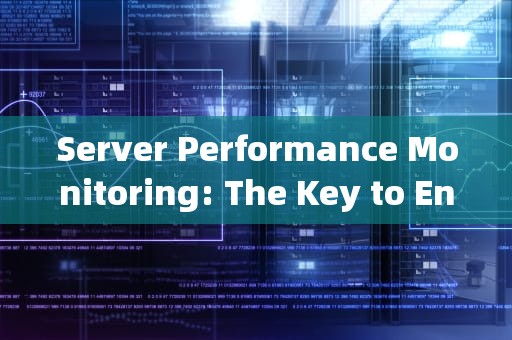In the digital age, servers have become the backbone of modern business operations. They power websites, applications, and a myriad of other services that are critical to daily operations. However, like any complex system, servers can encounter issues that may lead to downtime or reduced performance. This is where server performance monitoring comes into play. By continuously tracking various aspects of a server's operation, performance monitoring tools can provide early warnings of potential problems, allowing administrators to take proactive steps to maintain system stability and efficiency. In this article, we will explore the importance of server performance monitoring, the key metrics to monitor, and the benefits of implementing a robust monitoring strategy.

The Importance of Server Performance Monitoring
Server performance monitoring is essential for several reasons. Firstly, it helps in identifying and resolving issues before they escalate into major problems. By continuously monitoring the health and performance of servers, administrators can detect anomalies and address them promptly, minimizing downtime and its impact on business operations.
Secondly, performance monitoring aids in capacity planning and optimization. By analyzing historical data and current trends, organizations can make informed decisions about when to scale up or down their infrastructure to meet changing demands. This ensures that resources are used efficiently and cost-effectively.
Lastly, monitoring contributes to security and compliance. Many regulatory frameworks require organizations to demonstrate due diligence in safeguarding their IT systems. Regular monitoring can help in meeting these requirements by providing evidence of proactive maintenance and timely response to incidents.
Key Metrics to Monitor
When setting up a server performance monitoring system, it's crucial to focus on the right metrics. Here are some of the most important ones:
The Central Processing Unit (CPU) is the brain of the server. Monitoring CPU usage helps in understanding how much processing power is being consumed at any given time. High CPU utilization over extended periods can indicate that the server is overworked and may need more resources or optimization.
Memory, or RAM, is vital for the smooth operation of applications running on the server. Keeping an eye on memory usage ensures that there is enough available memory for processes to function without excessive paging, which can slow down performance.
Input/Output operations per second (I/O) measure how quickly data is read from and written to the disk. High disk I/O can be a sign of contention or a need for more storage capacity or faster drives.
Monitoring network traffic helps in identifying bottlenecks, unusual patterns, or potential security threats such as DDoS attacks. It also provides insights into bandwidth usage and the need for network upgrades.
The time it takes for a server to respond to requests is a direct indicator of user experience. Slow response times can frustrate users and drive them away, making this metric critical for web servers and application hosts.
Keeping track of error rates, such as HTTP errors or failed login attempts, can help in identifying underlying issues that might not be immediately apparent through other metrics.
7. Uptime and Downtime
Tracking the amount of time a server is operational versus non-operational is fundamental for assessing reliability and availability. High uptime percentages are indicative of a well-maintained and reliable server environment.
Benefits of Implementing Robust Monitoring Strategies
Adopting a comprehensive approach to server performance monitoring offers numerous advantages:
Improved Reliability and Availability
With real-time alerts and detailed reports, administrators can quickly respond to issues, reducing downtime and ensuring that services remain available to users.
Monitoring tools can detect suspicious activities and potential breaches, enabling prompt action to mitigate risks and protect sensitive data.
By optimizing resource allocation based on actual usage patterns, organizations can avoid unnecessary expenditures on hardware and software licenses.
Better User Experience
Faster response times and minimal disruptions lead to higher satisfaction among users, which is crucial for customer retention and brand reputation.
Streamlined Troubleshooting
Having access to detailed performance data simplifies the process of diagnosing problems and implementing solutions, leading to quicker recovery times.
In conclusion, server performance monitoring is an indispensable practice for maintaining the health and efficiency of IT infrastructure. By focusing on key metrics and leveraging advanced monitoring tools, organizations can ensure optimal performance, enhance security, and achieve significant cost savings. As technology continues to evolve, so too should our approaches to managing and monitoring server environments, keeping pace with the growing demands of the digital world.
随着互联网的普及和信息技术的飞速发展台湾vps云服务器邮件,电子邮件已经成为企业和个人日常沟通的重要工具。然而,传统的邮件服务在安全性、稳定性和可扩展性方面存在一定的局限性。为台湾vps云服务器邮件了满足用户对高效、安全、稳定的邮件服务的需求,台湾VPS云服务器邮件服务应运而生。本文将对台湾VPS云服务器邮件服务进行详细介绍,分析其优势和应用案例,并为用户提供如何选择合适的台湾VPS云服务器邮件服务的参考建议。

工作时间:8:00-18:00
电子邮件
1968656499@qq.com
扫码二维码
获取最新动态
